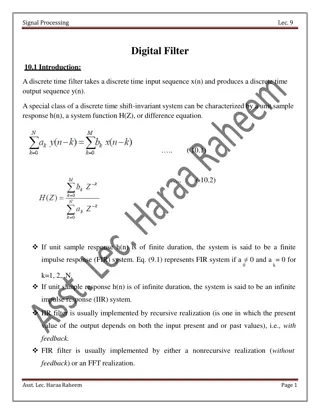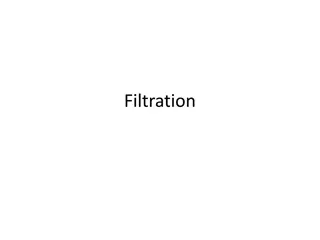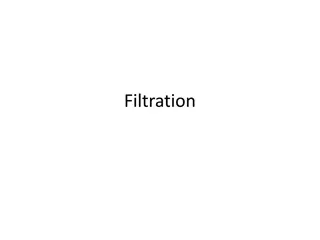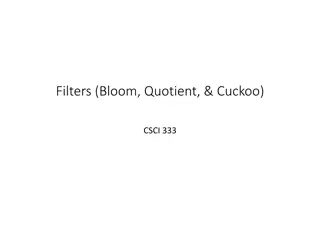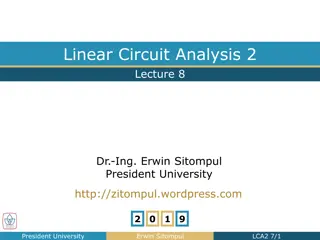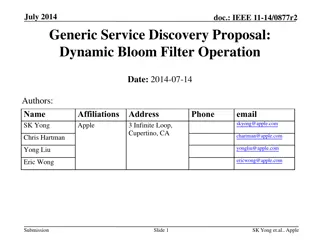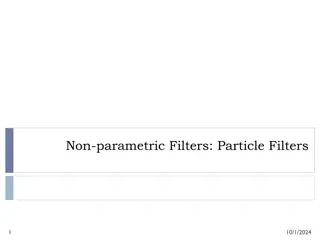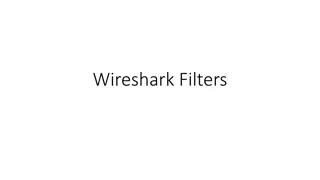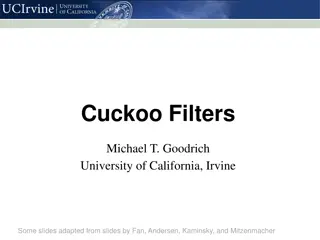Bloom Filters
Set data structures, specifically Bloom filters, are explored in this Spring 2016 course on Hadoop-Based Distributed Computing. Learn about the concept of Bloom filters, set membership tests, and how they can be used for error-free membership checks, removing duplicates, and other set operations. Dive into the mathematical magic behind Bloom filters and understand their applications in data science projects.
Download Presentation

Please find below an Image/Link to download the presentation.
The content on the website is provided AS IS for your information and personal use only. It may not be sold, licensed, or shared on other websites without obtaining consent from the author.If you encounter any issues during the download, it is possible that the publisher has removed the file from their server.
You are allowed to download the files provided on this website for personal or commercial use, subject to the condition that they are used lawfully. All files are the property of their respective owners.
The content on the website is provided AS IS for your information and personal use only. It may not be sold, licensed, or shared on other websites without obtaining consent from the author.
E N D
Presentation Transcript
Bloom Filters An Introduction and Really Most Of It CMSC 491 Hadoop-Based Distributed Computing Spring 2016 Adam Shook
Agenda Agenda Discuss what a set data structure is using math terms Discuss the concept of a Bloom filter Explore the mathematical magic behind Bloom filters
Set! A set is an unsorted data structure containing unique values Most common uses are: Error-free set membership tests Storing unique members of data (remove duplicates) Iterating through data in no particular order Other fun operations like unions, intersections, subsets, etceteras! Other sets support sorting and duplicate values But we aren t here to talk about those
Set Insertion peter lois chris peter stewie chris stewie lois chris peter insert
Set Membership Test stewie lois chris peter is_memb er peter
Set Membership Test stewie lois chris peter is_memb er adam
Use Case! I ve got a bunch of interesting keywords, A I ve got a data set B I want to check if a record in B contains a word in A Make a new data set C for some cool data science for each record x in B for each word w in x if w in A emit x
Use Case, Solved! Stuff all the data in A into a set Get an A+ on your computer science project Impress the boss But what if A is stupid big? credit to mr. squarepants
Memory Footprint A contains 1 billion unique strings, average of 32 characters in length 8 bits per character 32 characters per string 1 billion of them 8 bits * 32 * 1,000,000,000 Roughly 29.8 GB of raw storage required to hold these elements + overhead + even more if you are using Java For the sake of argument, let s all agree that Adoesn t fit comfortably on a computer
Making a Set Smaller What two features of a set can we relax to meet our requirements and have a reasonable memory footprint? Functionality Only want set membership operations Accuracy Don t really need to be 100% accurate
Use Case, Revised! I ve got a bunch of interesting keywords, A I ve got a data set B I want to check if a record in B contains a word in A Make a new data set C for some cool data science I don t really care if some stuff in C doesn t contain words from A for each record x in B for each word w in x if wis likely in A with false positive p emit x
Let me paint you a story We travel back to 1970 Burton Howard Bloom was investigating means to eliminate unnecessary disk accesses for particular algorithms Came up with the a probabilistic data structure for set membership Useful for programs with expensive operations where the operation is often unnecessary A structure only 15% of the size of the original can eliminate 85% of unnecessary disk accesses
Bloom Filter A space-efficient means to test if an element is a member of a set Elements can be added, but cannot be removed Storage cost for a single element is independent of the element size The members are not stored, so they cannot be retrieved There are no false negatives, but false positives are possible
How Its Made Training a Bloom Filter Given An array of bits size m, initialized to 0 k hash functions n elements foreach element ni in n foreach function ki in k m[ki(ni) % m] = 1 Training a Bloom filter is O(n)
How Its Made Training a Bloom Filter peterlois chris 0 1 0 1 0 1 0 1 0 1 0 1 0 0 0 1 0
How Its Made Membership Testing Given A trained Bloom filter of size m The same k hash functions An element x foreach function ki in k if m[ki(x) % m] is 0 return false return true Testing a Bloom filter is O(1)
How Its Made Membership Testing 0 1 1 1 1 1 0 1 0 1 peter
How Its Made Membership Testing 0 1 1 1 1 1 0 1 0 1 adam
The Catch What we make up for in space, we give up the accuracy I give you the false positive! 0 1 1 1 1 1 0 1 0 1 cleveland
Controlling the False Positive Rate Given Approximate number of elements in A, n A willingness to tolerate a percent p of false positives k is the optimal number of hash functions We can approximate m If you want the full details, read the paper or Wikipedia
Back to our use case n = 1,000,000,000 p = .1 After dusting off the calculators . m = 4.792 x109 bits or 0.558 GB An improvement of 29.8/0.558 = 53.4!
And now that we have m m We can use n and m to calculate k = m/n * ln(2) But I haven t heard of 3.32 hash functions so let s call it 4
References Wikipedia







